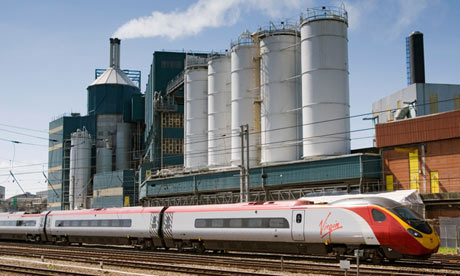Is it greener to travel by rail or car?
Advances in research and technology challenge assumptions that trains are automatically greener than transport by road

-
- Guardian Professional, Friday 26 July 2013 02.08 AEST
- Jump to comments (1)

Almost universally accepted by business, and rarely challenged, is the received wisdom that rail transportation is greener than travel by road. But does this assertion still hold true?
This is no mere academic pursuit. Transportation is one of the fastest growing contributors to climate change, accounting for around a quarter of energy-related carbon dioxide emissions. Many experts foresee a five-fold increase in transport-related CO2 by 2030 in Asia alone.
In India, annual vehicle production has rocketed by 110% over the past six years. Production lines churned out 20.4m vehicles in 2012, compared to just 9.7m in 2006. In China, the world’s second largest economy, the vehicle population is set to soar to about 300m by 2030, from 65m in 2010.
In absolute terms, the picture is clear. Worldwide, road users account for about 71% of transport CO2 emissions, with railway companies making up less than 1.8%, next to 12.3% for aviation and 14.3% for shipping, according to the International Energy Agency and International Union of Railways.
Finding out whether road or rail is the most eco-friendly mode of travel is more difficult when trying to make a comparison passenger-for-passenger, however. There are so many factors for businesses to consider: from fuel type and speed to occupancy rate and load.
“If the train is going anyway, and you’re trying to decide which to use [road or rail], it obviously makes sense to take the train,” says Roger Kemp, former UK technical and safety director for Alstom Transport, manufacturer of TGV and Eurostar. “The additional energy consumption and emissions from you getting on are absolutely insignificant.”
But if the train is powered by diesel, with refined crude oil as its primary fuel source, and you have the option of using a hybrid electricity powered vehicle instead, then the equation may change, suggests Kemp, who has studied how, over some distances, many trains perform badly in comparison to cars.
“Diesel trains are frankly not that much different to cars. If you take a current car – say a small Citroën – which generates about 100 grams of CO2 per kilometre, that works out about 70 grams per passenger on average. It’s only when you get onto the electric trains, such as the Pendolino, which is down to 50 grams of CO2 per passenger, that cars just can’t compete.”
Despite being a former rail worker, Kemp is clearly not your typical railway enthusiast. “I’m very suspicious of some people in the environmental movement who take this ‘trains good, cars bad’ attitude. It’s an Animal Farm mentality of ‘four legs good, two legs bad’.” After all, electric trains are hardly green if powered from the grid by coal-fired plants.
Are car manufacturers streets ahead in green technology?
Spurred on by ever stricter regulations, technological advances have dramatically reduced the footprint of road vehicles in the past 20 years. In 1998, most new cars in the UK emitted an average of 186 grams of carbon dioxide per passenger kilometre. By 2020, cars will be required by the European Union to emit almost half of this: no more than 95 grams.
It is no longer inconceivable that motor vehicles could one day rival electric trains, notes Kemp. “Because trains last a lot longer, those that were built in the last five years are still going to be with us for the next 20 years. Even if you introduced a super efficient train tomorrow it would be a lot of time before most trains would be using that type of technology.”
In India, one car manufacturer seeking to demonstrate the potential of new automobile technology is Mahindra Reva, based in Bangalore. In March this year it launched its new e20 electric car, a hatchback running on lithium-ion batteries.
The vehicle has a top speed of 80 kilometres an hour and a range of 100 kilometres per recharge which, when coupled with a solar power source, promises zero emissions.
With a price tag of around £9,800, the e20 remains unaffordable for most Indians. As far as Chetan Maini, Mahindra Reva’s chief executive, is concerned, however, the car nonetheless demonstrates how climate change pressures are encouraging the development of new innovations.
“For us, the advancement of battery technology leading to better range, higher speeds and also light weighting of vehicles will be the key,” he says.
Looking beyond the tailpipe
Technology is not the only factor undermining the standard argument made for rail travel. Recent studies by US researchers from the Universities of California and Arizona have found that too little attention is given to the auxiliary emissions generated by both rail and road infrastructure and supply chains.
Their argument goes that business needs to look beyond the tailpipe, so to speak, to the materials used in construction, lighting, salting and maintenance, as well as parking and even power for lighting and station escalators. Not factoring in these may give you the impression that rail is less carbon intensive than is in fact true.
“These activities have been accounted for in the past, but under different economic circumstances and they haven’t been attributed to transit,” says Mikhail Chester, assistant professor at Arizona State University. “The maintenance of infrastructure over the long run has significant environment impacts. It could even double the footprint of the mode.”
There are the other sustainability factors to consider: the greenfield sites bulldozed to make way for motorways and railway tracks and the respiratory and other ill health effects caused by pollution, not to mention social and economic impacts, such as traffic accidents.
Might rail be at risk of losing its claim to be greener than road travel? Not yet, asserts Chester, although the distance between the two may have narrowed. “As engine technology becomes more energy efficient and fuel become less carbon intensive, I think rail will maintain the edge,” he says.
“Cars are going to get greener in many different ways, through electrification and hybrid cars. But you also have advances in train technologies. We can’t forget that. Trains are not static, just like car innovation is not static.
“Even when you include, in addition to the tailpipe, the CO2 emissions from infrastructure, fuel production and the supply chain, on average rail will still have a lower carbon footprint than road travel, when comparing life-cycle to life-cycle.”
This content is brought to you by Guardian Professional. Become GSB member to get more stories like this direct to your inbox
